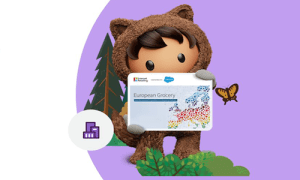The pandemic reshaped the European grocery industry over the past year, as consumers turned to online grocery shopping, and the digital experience became a bigger priority for 47% of the industry. While other sectors were massively disrupted by lockdown measures and changing consumer behaviour, grocery retailers innovated at speed.
A wave of optimism for European grocery retailers followed, with 77% of leaders predicting that their business will outperform the sector in 2021. In fact, 39% of European grocery retail executives say that the crisis presented nothing but an opportunity for their business.
To find out what’s changed in the wake of the pandemic – and what the future might hold for the industry – we, in collaboration with Internet Retailing, surveyed and interviewed leading retailers, FMCG, and CP brands across Europe. Check out the results in the European Grocery Report.
Here are some country-specific insights from the report.
The shift to online grocery shopping is a turning point for the UK
The pandemic forced many European grocery retailers and brands to accelerate their digital roadmap, resulting in a sector that’s more customer-centric, forward-thinking, and technologically engaged than it was just a year ago. UK grocery chain Co-op managed to condense a five-year digital transformation plan into a single year, with 850 stores rolling out online grocery operations.
“We had lots of plans around the customer experience, search, and CRO, and the usual things you would talk about in an online world,” says Chris Conway, head of e-commerce, Co-op. “Suddenly, they were not as important as they once were, since people just wanted access, to be able to shop”. As a result of this rapid transformation at scale, Co-Op has seen a 10x increase in the volume of online grocery orders, attracting an army of new customers.
Many other UK businesses also experienced massive digital growth, as the country’s supermarkets saw a 101% increase in web traffic in Q2 of 2020 compared to the same quarter in 2019. This is nearly 3x the YoY growth experienced by non-grocery retailers in the UK, and well above the average growth in online traffic across Europe (78%). Having grown accustomed to the ease and convenience of online shopping, many of these customers will become digital-first shoppers, enabling grocery retailers to engage with them in new ways.
France focuses on building better relationships
The shift to online has recalibrated customer behaviour, and agility has become more important than ever. The report reveals that less than half (48%) of consumers in France now shop for groceries at least once a week — compared to 67% before the pandemic. Consumers are shopping less frequently, shopping for healthier and more ethical products, and using different channels to do it — with supermarkets in France seeing a 54% uptick in online traffic in Q2 of 2020 vs Q2 of 2019. Adapting to that changing behaviour is crucial, and many brands tested D2C models in a bid to harness the power of consumer data and build better relationships.
Hervé Beck, general manager of France, Benelux & EMEA, Kind, says, “For the multinationals, D2C is definitely not a sales channel compared to the traditional channels. I view it as a fantastic data collection system where you can get to know your customers better, but it’s not really efficient in terms of sales, as you do not have the scale. The big corporations will treat D2C as a data collection channel. ”
Grocery retailers across Europe are innovating to get closer to the customer
The ability of Europe’s grocery retailers and consumer goods companies to overcome challenges, quickly adapt to changing behaviour and navigate a sea of new regulations and safety concerns has been impressive. If any of these businesses were already headed towards an online future, the pandemic accelerated those efforts. Today’s consumers have more ways to shop than ever, and in turn, retailers and consumer goods companies have more ways to communicate with them.
For Delhaize in Belgium, getting closer to the customer has meant rolling out a more personalised loyalty programme. Jonathan Hertog, director of digital, e-commerce, and CRM, Delhaize, says, “We used to have a very transactional loyalty programme which was old school in that shoppers earned points for every euro they spent. We changed our strategy to one that supports people in eating and living healthier. The loyalty scheme is also much more interactive. Customers can exchange their points for products or vouchers with our non-food partners.”
Benelux saw a 70% YoY increase in web traffic to supermarkets in Q2 of 2020 vs Q2 of 2019, so finding creative ways to build meaningful relationships with these new digital consumers is now a top priority.
One way to earn the trust of consumers in the current climate is to prioritise their well-being and values. Like Delhaize, Finnish retailing cooperative S-Group is leveraging data to better serve its customers. The S-Group’s newly relaunched loyalty app enables shoppers to take a deep dive into the sugar, fat, and salt content in their basket, as well as to research the provenance and carbon footprint of their purchases.
The Nordics have seen a 63% YoY rise in supermarket web traffic, and by addressing consumers’ potential concerns about climate change and health, the S-Group is offering an attractive differentiator.
The future for European grocery retailers
A quick look at the numbers in various countries shows just how much of a massive shift there was to digital in the grocery industry last year. In Q2 of 2020 (vs Q2 of 2019): Italy grew +246%, Germany +34%, Spain +42% and Switzerland +27%.
It’s clear that today’s shopper is increasingly digitally savvy, with many originally forced onto digital channels because they had no other option, but now stay for convenience. Grocery retailers and consumer packaged goods companies have made the most of this transformative moment, rolling out innovative new technologies that put the customer first.
Indeed, many European grocery retailers have used — and continue to use — the disruption as an impetus for change.
To see more about how grocery retailers in Europe are overcoming challenges, download the European Grocery Report.

























